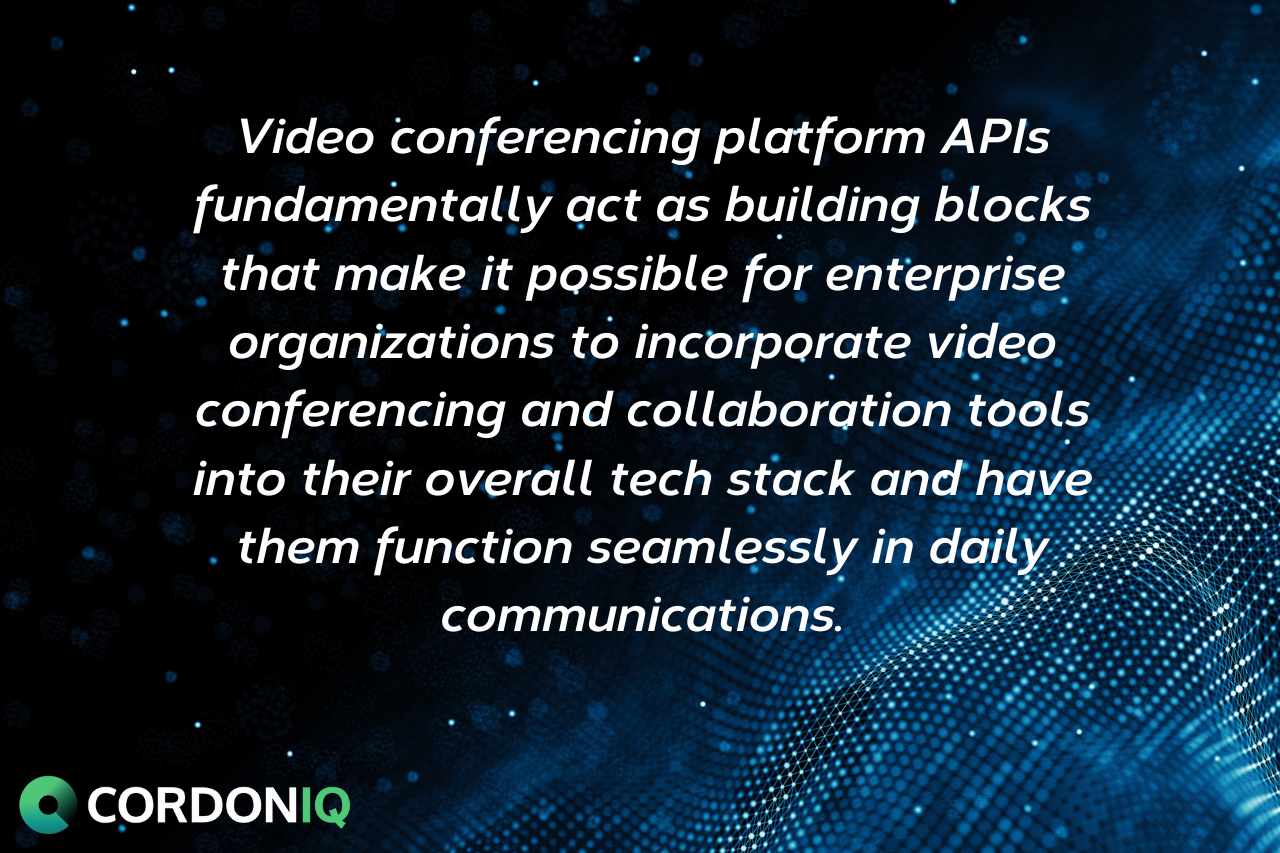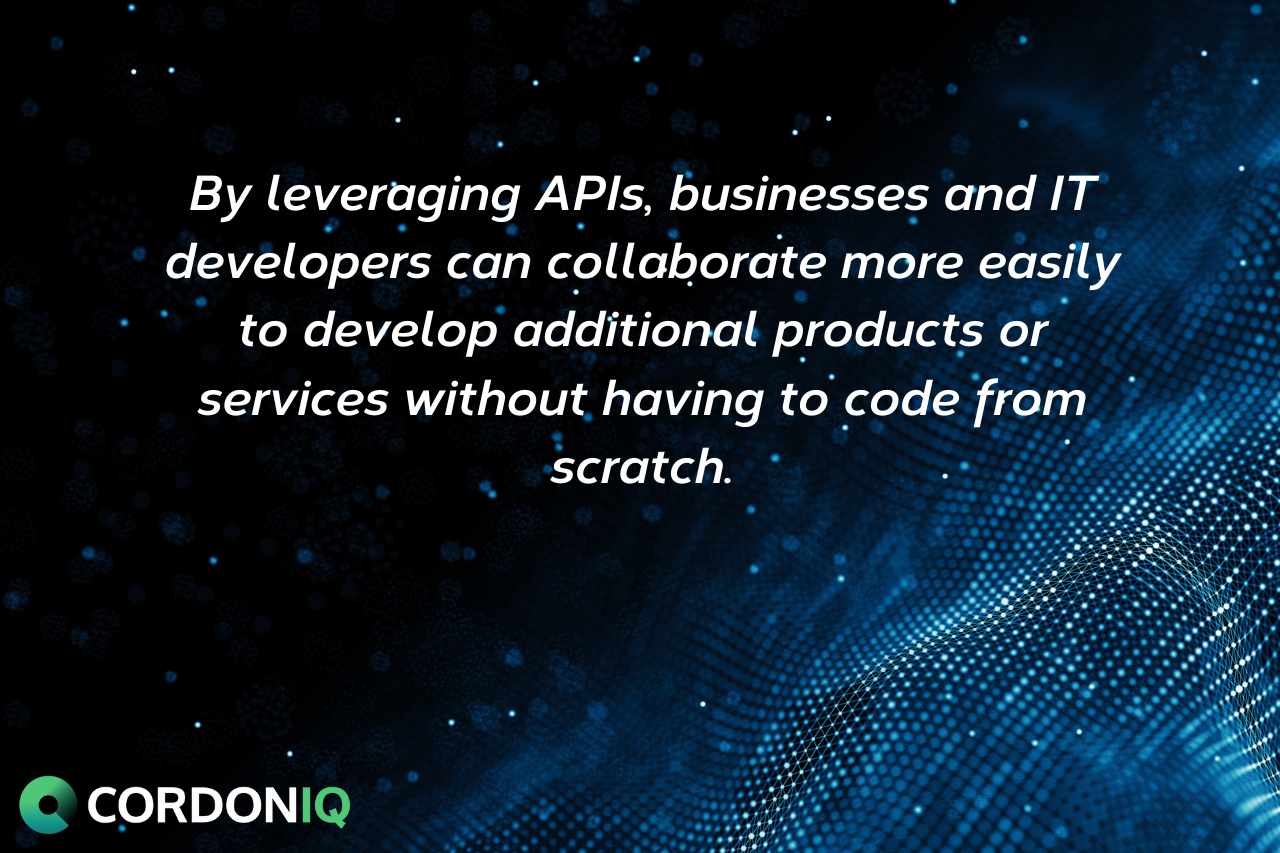Secure and high-quality video conferencing and collaboration solutions are critical tools in today’s remote and hybrid working environment. Video conferencing platform APIs form the foundation for the development and production of these tools.
Firms using a superior quality video conferencing platform find it easier to establish a productive and equitable enterprise remote work setting. Video conferencing and effective collaboration methods support teams by boosting productivity, optimizing connectivity, promoting well-being, and advancing innovation. Video collaboration solutions are cost-effective and give organizations the ability to leverage a global workforce.
For many industries, such as financial services, banking, insurance and management consulting, video conferencing is an essential component of day-to-day functions and operations, including sales, collaborative work, brainstorming, training, hiring and onboarding. Enterprise firms, such as software development and management consulting firms, have been able to expand their services and elevate user and customer experience through B2B video collaboration.

Video conferencing platform APIs fundamentally act as building blocks that make it possible for enterprise organizations to incorporate video conferencing and collaboration tools into their overall tech stack and have them function seamlessly in daily communications. Software development professionals can leverage the benefits of video conferencing platform APIs to create secure and dynamic video collaboration experiences for their teams and clients.
Before diving into video conferencing platform APIs, here is a brief overview of what APIs are, how they are generally used, and why they’re imperative for developers within modern organizations to deliver products and services quickly and efficiently.
What is an API?
An Application Programming Interface, or API, is a set of protocols and definitions that allows two software applications, or products and web services, to interact or talk to each other. When applications leverage APIs, they can communicate without needing to know how the application works. The application only needs to know how to use or connect to the API.
With the help of APIs, developers can connect disparate software or systems without the need to know the specific coding. Software developers can then enable their own users or customers to indirectly use the service or services provided by the API solution.
APIs are used to integrate new applications with existing software systems. This increases development speed because each functionality doesn’t have to be written or coded from scratch.
Because of their out-of-the-box functionality, APIs allow developers to innovate faster, create new and better experiences, and exchange information quickly and securely.
An API consists of two parts:
- Technical specifications and documentation: This information explains how you’ll need to integrate the API to use it effectively. API documentation provides the interface that developers need to utilize the integration.
- The interface itself: You can access it directly via keyword (in the case of a web API) or indirectly from a separate interface (in the case of a REST API).
APIs are categorized into several types, depending on how they are used and accessed, even though they function essentially the same way.
- External or public APIs – can be easily accessed by developers and third parties in order to access data or services.
- Partner APIs – are shared by business partners.
- Internal APIs – work with internal systems and are accessed by only internal teams for development purposes.
Developers gain several advantages for their enterprise clients when they use APIs for application development and integration. The concept of an API-first development model has gained popularity as a result of some of these benefits. An API-first model prioritizes building APIs that serve all applications and that run efficiently on all devices, platforms, and operating systems.

Today’s organizations need to quickly deliver products and services in order to stay competitive in their markets and industries. By leveraging APIs, businesses and IT developers can collaborate more easily to develop additional products or services without having to code from scratch. Software developers can reuse APIs to speed up the application development process, allowing for reduced time in getting products to market.
The leveraging and sharing of APIs and their related business benefits are sometimes referred to as the API Economy. The term also refers to companies that have monetized their APIs.
Through APIs, businesses can more easily and efficiently expand their products and services. An API software development model helps organizations stay competitive by creating new opportunities for digital transformation. With APIs, developers are finding it easier to customize, create and deliver new business services and products to meet the changing preferences of customers and users. In recent years, firms in many industries have been transformed as a result of leveraging the benefits of APIs, such as banking, insurance, finance, consulting, telecommunications, travel, entertainment, and media.
Some popular examples of how APIs are used include workflow processes and management, universal logins for websites or social media, web smart devices (or Internet of Things devices), payments, weather, and mapping apps. APIs are also a key element of Software as a Service (SaaS) or Platform as a Service (PaaS) products. APIs allow development companies to expand and customize these solutions with integrations.
What are REST APIs?
Representational State Transfer (REST) is a type of software architecture used for APIs. REST APIs use the JavaScript Object Notation (JSON) programming language and a URL structure to govern the communication between two pieces of software. Sometimes known as RESTful APIs, they are helpful in interacting with web-based software.
Basically, REST APIs impose specific conditions on how an API should work. REST APIs use HTTP protocol for transmitting data, which allows interaction between programs and systems that are written in different programming languages. REST APIs can be secured using authentication tokens or API keys.
A RESTful API call follows specific steps that consist of a number of requests and responses between the client and the server using the API. Developers provide an explanation on how the REST API should work in the API documentation itself.
REST APIs have a number of key benefits that make them especially developer-friendly:
- Speed and flexibility – REST APIs are fast and versatile, allowing developers to more easily create apps and web services.
- Statelessness — REST APIs are stateless, which means that servers do not save client data between requests. This concept of “working in the now” gives REST APIs additional flexibility.
- Easier integrations — REST APIs enable integrations of new apps with existing systems.
REST APIs help bring scalability to cloud-native app development.
A discussion of REST APIs also involves the OpenAPI framework. OpenAPI 3.0 is an open-source format for describing and documenting APIs. This framework is considered the standard for designing, producing, consuming and describing REST APIs or RESTful web services.
Millions of developers and organizations use the OpenAPI framework for developing apps because of several benefits.
OpenAPI is especially valued by developers as the technology eliminates the need to write code by hand to integrate different types of apps and programs. With OpenAPI, it’s faster and more efficient to seamlessly connect disparate programs and applications.
In addition, developers find that using the OpenAPI framework improves collaboration and communication between 3rd party customers, services, and apps. Because OpenAPI is programming language agnostic, it makes it easier for users and systems to understand the capabilities of the API without needing any additional documentation or source code.
With OpenAPI, software developers are able to easily create headers and integrate with their programming language of choice, with a variety of automated integrations for almost every available language on the market today.
What is an SDK and what is it used for?
Another key development component is a software development kit, or simply SDK, which is also referred to as a devkit. An SDK is a collection of documentation, APIs, programmer tools and examples that allows a third-party developer to consume a specific solutions platform.
The SDK consists of software-building tools for a specific platform, including the building blocks, debuggers and, often, a framework or group of code libraries such as a set of routines specific to an operating system (OS).

Because SDKs provide a comprehensive collection of tools, software developers can use an SDK to build new software apps or services or build on existing ones in a standardized way.
Tools typically included in a basic SDK include APIs, documentation, libraries, sandbox testing environments and other components.
What is a video collaboration SDK?
A video collaboration SDK is a software development kit (SDK) specifically built for allowing the integration of video conference and collaboration capabilities, provided through APIs, into existing products and services and that enable a unique collaboration solution on your own platform. The tools in a video SDK enables developers to build or customize an app for a variety of video services, including live streaming, audio, and screen sharing.
By leveraging a video SDK, developers can more quickly and easily add video services to websites, apps, products, or services. For example, developers can use a video SDK to embed live video streaming in a website, or create and control various streaming video services without having to develop the code themselves.
The benefits of using a video SDK are similar to the benefits of leveraging APIs and include:
- Scalability and flexibility
- Adaptability
- Cost-effectiveness
- Speed and efficiency
- Platform agnosticism
What is an API in video conferencing? (OR How is an API used for video conferencing?)
By using an API for video conferencing, it’s possible to quickly add video capabilities to web applications, websites, and mobile apps. A video conferencing API makes it easier to integrate video conferencing into apps, workplace tools, products and software applications. In addition, a developer can add video to any app natively when using a video conferencing platform API.
Developers can leverage a video conferencing platform API to create and build custom experiences for conferencing and collaboration. Some robust interactive experiences that can be created using tools included in a video conferencing API include video calling, B2B video collaboration, meetings, chat, whiteboard collaboration, note taking, breakout rooms, one-on-one conferences, screen sharing, audio, and other interactive features.
Because of their versatility, APIs can be used to add video services for not only websites but also mobile apps using iOS, Android platforms.
What are some other benefits of using a video conferencing platform API for developing video services?
- No need to code by hand. Thanks to video conferencing APIs, businesses don’t need to build video services for their apps or websites from scratch – a cost-prohibitive undertaking for most firms.
- APIs offer easy and efficient scalability and flexibility depending on demand.
- Developers have the ability to use a video conferencing API to quickly and easily customize products and services.
- Video conferencing APIs allow for the implementation of a variety of security features and better data protection.
Finally, video conferencing platform APIs can allow deeper integration of other business tools such as project planning tools, customer resource management, and other communications tools that are found in an organization’s existing tech stack.
Choose Cordoniq for Your API-Driven Video Collaboration Platform
Cordoniq enables faster and more efficient API integrations with its customizable video collaboration platform. Cordoniq’s API-driven platform allows developers to customize their video collaboration solution through open standards-based, deep integrations that use their existing tech stack.
With comprehensive APIs for nearly every application, Cordoniq can integrate tools that support key areas including HR, sales, collaboration, training, testing, and onboarding for both clients and teams. Your development team will have the ability to create the video conferencing, B2B video collaboration, and advanced experiences that suit the specific needs of your organization.

Software development organizations can leverage Cordoniq’s benefits and features, while having access to documentation for all of the available resources through HTTP API calls. In addition, their entire API collection is documented for easy consumption using OpenAPI 3.
The Cordoniq platform offers a number of development benefits including the following:
- The ability to leverage APIs and SDKs to create fast and efficient customizations.
- Custom API development based on your specific needs and requirements.
- APIs are available in a variety of formats, for example, REST-based, webhooks, or as subscriptions to events and actions that occur when attendees perform certain tasks.
Developers can easily and efficiently integrate almost any business tool into Cordoniq’s video collaboration platform for a complete, seamless experience that offers unparalleled security and functionality.
Custom integrations are available for virtually any business process tool including project planning, communications technology, sales, accounting, distance learning, eCommerce, financial services, information technology, insurance, legal, and telecom software applications and categories.
In addition, Cordoniq offers a comprehensive SDK solution to its partners that not only includes REST-based, OpenAPI compatible interfaces and related documentation, but also the ability to directly interface with a variety of programming languages and interfaces.
Some of these interfaces include an easy-to-use client SDK for C Sharp, Go, Java and Javascript, Kotlin, PHP, Python, Scala, Swift and Typescript among others.
Partners can directly interact with their client SDKs and APIs by visiting the following OpenAPI resources:
- https://app.swaggerhub.com/apis/cordoniq/cordoniq-core/v1
- https://app.swaggerhub.com/apis/cordoniq/cordoniq-content/v1
- https://app.swaggerhub.com/apis/cordoniq/cordoniq-auth/v1
Customers can choose to ‘Export’ to their favorite developer platform by navigating to the Export menu in the upper right corner of the page.
Cordoniq’s API-first software development model means reliable APIs that won’t change or break with future updates to the platform. In addition, with its open standards-based approach, using OpenAPI and an easy-to-use Http/REST interface, they can integrate with almost any interface you have.
Learn how Cordoniq’s video collaboration platform can help your development team achieve superior and secure video collaboration experiences for your clients.